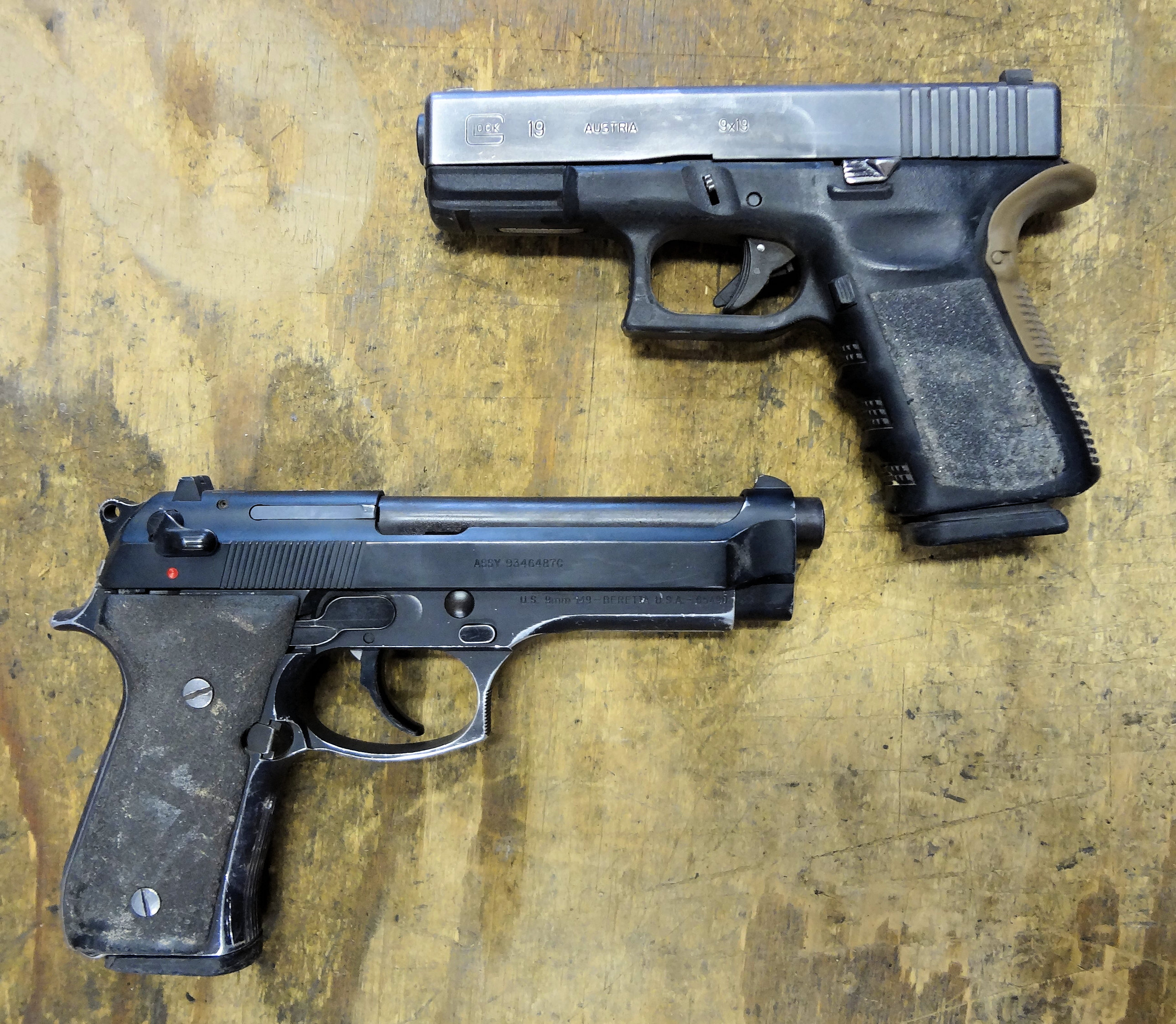History Of Glock - A common question for new Glock buyers is "What is my Glock?" Before the release of the 4th generation, Glocks were not officially known by anything other than model numbers, contributing to the perception that "a Glock is a Glock is a Glock-they are all the same." But early adopters noticed the differences and roughly divided them into three main iterations or "generations". It is common knowledge that Glock followed suit with the release of the Gen 4 in 2008 and their promotional brochures now feature the previous Gens in some places.
The pictures below will help you identify which generation your Glock belongs to, but keep in mind that many overlap as models are slowly replaced. Also, 3rd Gen guns are still in production due to California's manufacturing regulations, so you may have a Gen 5 gun that is older than your Gen 3! The notes in the pictures identify the main characteristics that are consistent in all generations, but small changes in symbols and internal structures can be seen at different intervals - sometimes back and further - within the same lot. Important legislative reforms, many of which are changed over two or more periods, but some changes are made only temporarily within a generation.
History Of Glock

The 1st generation is one of constant change. The initial design, while reliable, is still under development. The standard feature is a grip system that wraps around the entire grip (no front or back strap check). It is more attractive compared to later generations and is considered a "pebble texture" by collectors. Early guns had a slim, stainless steel barrel, and Parkerized finish was made early (not after the AD phase) and the barrel wall thickness was increased over the AN phase. There are also many variations on the magazine, case and small internal parts. All guns have Austrian proof marks, but no fixed position or number of marks. Early guns (pre-US) and guns intended for European markets do not have a serial number plate on the frame. Most early rifles were equipped with target sights called "weak sights" because of their inefficiency. The standard (fixed) displays are also timed, although the target version will command a premium. All frames have a half moon mag well relief on the bottom of the front straps.
Glock Introduces The .22 Cal G44 Handgun
2nd Gen is what many new collectors or even uniformed dealers refer to as "Gen 1". The confusion comes from two things: 1. 1st generations are very rare and many casual observers have never seen them before. 2. Several models were made in the 2nd Gen line, and some consider them "1st Gen" because that was the first release of that particular model. To clarify things, if you have a Model 20 or higher, you have a Gen 2 Glock, even if it is the original version of the gun. The only obvious difference between the 1 and 2 for the 17-19 models is the addition of checking to the front and spine, as well as a change in the layout of the side panels (deeper than the 1st Gen). Gen 2 also introduced 5 additional calibers and all non-.380/9mm guns were fitted with a second locking pin to prevent frame cracks from heavy recoil. It is important to note that the number of injections does not indicate vision, as many believe. 9mm frames from Gen 1 to Gen 3 production only have 2 pins, all other calibers have 3 pins. All full frames are mounted on a mag well at the bottom of the front strap.
By the late 90s, Glock had become the dominant force in the American gun market and other manufacturers were clamoring to copy the design. This led to some pressure to "innovate" the Glock design. The Gen 3 changes really started in 1995 with the release of the sub-compact models. It is believed that the handle will be too small for most people, so the fingers are designed into the front strap to try to increase and avoid buying. Rotation due to reaction. It began a 3-year facelift until 1998, when all models received a complete overhaul. Some large frame transition models are very rare (especially in transmission variants) — see https:///transitional/ for more information. The Gen 3 front strap has finger tips, thumb rest indentations on the top of the grip, and a patterned support rail on the dust cover. As mentioned above, 2-pin designs were found in the early Gen 3 run, only for 9mm calibers. In the early 2000s the frames were standardized to all 3-pins.
By the time the 4th generation came out, Glock had become ubiquitous for the "pistol" but was also challenged with more new designs. One of the fads that attracts customers is having interchangeable backs to better fit the handle on different hand sizes. Glock first experimented with curved grips on the Gen 3 SF models (which were only available in .45 and 10mm calibers). The modular back system brings SF dimensions to all frames with two scale-up options and beaver tail adapter inserts. The internals were redesigned from the ground up and were actually built with the .40S&W recoil profile in mind, then reduced to 9mm (where Gen 1-3 were designed the opposite way). This should make the .40 models more durable while continuing the legendary reliability of the 9s. The handle pattern also changed to a more aggressive design on the side panels - again, this was the first test on a short run of Gen 3 rifles called the "RTF2" system. The RTF2's are Gen 3 technology, possibly Gen 3.5, and were only produced from 2009 to 2011 (except for Priet Special Editions) - see image at the bottom of this page.
The first Gen 5 models are actually the newly released 42 & 43 subcompact slim line models. These models began as redesigns with all new internal components to accommodate smaller sizes, and the FBI played a role in these changes. Out of the big guns with their request for the M models. The 19X, 42, 43, 43X, 44, 45 and 48 models do not have the Gen 5 selection on the slide, but often fit closely with the guns. Another Gen 5. The 17 and 19 were officially released as Gen 5s in 2017, and 9mm and .40 S&W offerings have followed, but so far there are no .357 Sig, 10mm, or .45 ACP offerings. we have done. Major changes to the Note include a "Marksman" barrel, fully ambidextrous controls, a flared magwell, and the removal of the front index finger.
Glock 43 9mm Single Stack Pistol (made In Usa)
There are (at least) two more styles that really fall from generational differences or are different enough to be hard to identify from the above context: 1. RTF2 Third Generations & 2 .FBI M-Series.
RTF2 stands for "Rough Texture Framework, Second Edition". The original version was only produced as a prototype and was never released although there is at least one on display at the Cody Guns Museum. Prototypes moved on to the second generation, and new designs were created to incorporate this handling system into the standard 3rd gen design. All internal parts are the same, so the only difference is the handle design. As you can see from the exploded view, the entire handle is in small pyramids - and let me tell you, they are sharp! This gun really stays in your hand even when it's cold. Glock sold these mostly to the police from 2009 to 2011, but the design is a clear step between the third and fourth generation pistols. The pyramid scheme has been carried forward, but with larger pyramids RTF2 is worn and worn through clothing. See https://rtf2g/ for more images.
Finally, we should also talk about the FBI's M series rifle. The 17M & 19M actually preceded and, perhaps, supported the Gen 5 rifles. They were developed to the specifications requested by the FBI as a new field service weapon and incorporated some design changes and some new ideas from the Mini model 42/43. These were the first Glocks to feature modified ambidextrous controls and changes to the rifling designed to improve accuracy. On the outside, though, the M gun looks a lot like the Gen 5. However, for the right person, the "M" added to the model's design can make a big difference in the price they want.

Glock 26 history, meaning of glock, models of glock, history of glock 19, glock 17 history, pics of glock 17, glock call of duty, price of a 40 glock, types of glock, glock 23 history, glock company history, pictures of glock 40